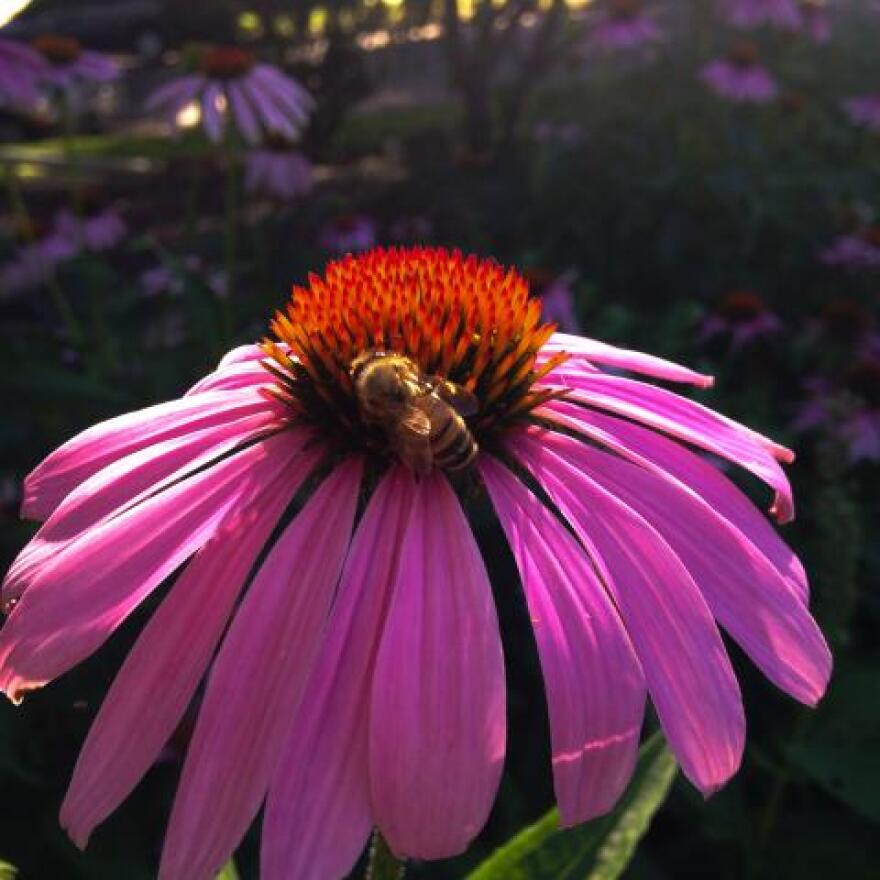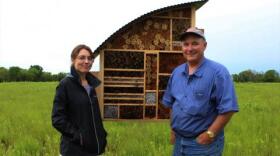Late spring is swarm season, the time of year when bees reproduce and find new places to build hives. Swarms of bees leave the nest, flying through the air, hovering on trees, fences and houses, searching for a new home.
It’s a rough time for bees, with the vital pollinators under threat. U.S. beekeepersreport losing about a third of their honeybee colonies each year in recent years, and the figure increased from 2014 to 2015. North America’s 4,000 other species of native bees are also declining.
While a new neighborhood beehive can be stressful for homeowners, it’s an exciting time for beekeepers, who see it as an opportunity.
Swarm Chasers
When a swarm is announced on the Bee Town Bee Club Facebook page in Bloomington, Indiana, beekeepers race to call dibs.
Kara Krothe posted pictures of the swarm in her tree on a recent Thursday evening.
“I thought it was pollen flying off the trees. I looked closer and realized they were honeybees,” she says. “I texted the neighbor and told her to take her kids inside because I didn’t know what was going on.”

On Friday morning, beekeeper Jill Stowers was in Krothe’s backyard looking up at the cluster of bees. After seeing the note on social media, Stowers left work in the hopes of capturing the wild bees. That means she’s not wearing any protective gear, and the paper filing box in her left hand is what she’s hoping to capture the bees in. But she’s not concerned about her safety, because swarming bees are calm.
“They’re not defending a hive,” Stowers says. “They don’t have a huge honey store they’re defending. They don’t have babies and pollen. So, we’ll see how that goes.”
Her plan is to climb a ladder and just shake the bees into the box. Easy.
Stowers maintains several colonies on her hobby farm and has coaxed new colonies onto her property twice already this season. Snagging these wild bees would be a money saver — if she can catch them. The more healthy bees beekeepers raise, the more honey they harvest, and the more local plants get pollinated.
Suddenly, the buzzing crescendos and the tight cluster from the tree evaporates into a haze around the backyard.
“It’s raining bees right now,” she says, as we notice drops of yellow goo falling from the sky.
Science Of Swarming
“That’s bee poop,” says honey bee specialist and Purdue University professor Greg Hunt.
To understand why bees swarm, Hunt says you have to understand how bees reproduce. There is only one queen per hive. She gives off a special pheromone so all the drones know to not make new queen cells. In the spring, when a hive grows its numbers, sometimes the pheromone doesn’t get evenly distributed to all the worker bees and some think it’s time to make a new queen.
The workers create queen cells and the queen lays eggs. Too many queens for one bee hive means it’s time to swarm. The old queen leaves in search of a new home, taking most of the workers with her.
Hunt says we can trace this season’s intense swarming activity to abnormally warm weather in March.
“This makes the bees build up their colony strength faster, and then we had that cold weather (in April), and the bees were cooped up in their hives,” Hunt says. “As soon as the weather gets good, off they go.”
He says swarming is a good thing for bees. It indicates they came from a healthy colony, and if all goes well, that swarm will become a new colony. They just have to make it through the winter.
On this day, Stowers came up empty-handed. The scout bees didn’t like the location, and the swarm flew off before she could cajole them into her box.
She has high hopes, however, that as bees continue to swarm through June, she’ll get another chance to re-home some pollinators.
This story was originally produced by Earth Eats









